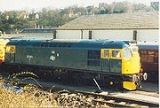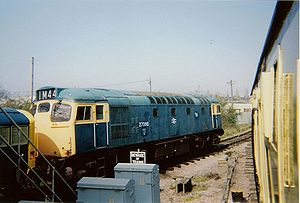
British Rail Class 27
Encyclopedia
British Rail
's Class 27 comprised 69 diesel locomotives built by the Birmingham Railway Carriage and Wagon Company
(BRCW) during 1961 and 1962. They were a development of the earlier Class 26
; both were originally classified as the BRCW Type 2.
. The last locomotives were withdrawn from service in 1987, being outlived by the older Class 26s, whose less powerful engines were more reliable.
These trainsets are incorrectly described as Class 126 but the individual vehicles are numbered in the 79xxx series thus were never allotted a BR TOPS classification. Class 126 units are Swindon's later build of 3-car trainsets numbered in the 51xxx/59xxx/51xxx series allocated to Glasgow St Enoch (later Glasgow Central) - Ayrshire and Stranraer services.
They were replaced in 1971 by specially adapted Class 27s fitted with push-pull
equipment to “top and tail” rakes of six Mark 2 carriages which were specially fitted with air operated disc brakes. At one end would be a Class 27/1, at the other a Class 27/2 (which provided train heating). The very intensive 90 mph (144.8 km/h) “push-pull
” service was demanding on the locomotives and reliability started to suffer. The 27/2s, especially, appeared prone to fire damage, especially from their electric train heating
alternator
s. The push-pull sets were replaced in 1980 by single Class 47/7s at one end of a rake of Mark 3 carriages
and a DBSO. The spare Class 27/1s were then transferred for use on Edinburgh-Dundee semi-fast passenger services, until their replacement by Class 150
Sprinter DMUs in 1987, whilst the 27/2 subclass was largely used on freight. Their ETH supply was no longer used.
s in Great Britain.

British Rail
British Railways , which from 1965 traded as British Rail, was the operator of most of the rail transport in Great Britain between 1948 and 1997. It was formed from the nationalisation of the "Big Four" British railway companies and lasted until the gradual privatisation of British Rail, in stages...
's Class 27 comprised 69 diesel locomotives built by the Birmingham Railway Carriage and Wagon Company
Birmingham Railway Carriage and Wagon Company
The Birmingham Railway Carriage and Wagon Company was a railway locomotive and carriage builder, founded in Birmingham, England and, for most of its existence, located at nearby Smethwick, with the factory was divided by the boundary between the two places...
(BRCW) during 1961 and 1962. They were a development of the earlier Class 26
British Rail Class 26
The British Rail Class 26 diesel locomotives, also known as the BRCW Type 2, were built by the Birmingham Railway Carriage & Wagon Company at Smethwick in 1958-59. Forty seven examples were built, and the last were withdrawn from service in 1993...
; both were originally classified as the BRCW Type 2.
Usage
Original allocations were D5347 - 5369 to Glasgow Eastfield, D5370 - 5378 to Thornaby and D5379 - 5415 to London Cricklewood for Tilbury Boat trains and Cross-London freight services. In the period September to December 1963, some of the Cricklewood allocation were transferred to Leicester and in December 1965 the Thornaby allocation was also nominally transferred to Leicester to join them. Traffic changes combined with reallocation of class 25 led to the gradual transfer of the Leicester and Cricklewood locomotives to Scotland during 1969 thus concentrating the whole class within Scotland and being part of the replacement fleet that allowed the withdrawal of the poorly performing Clayton Class 17 locomotives from traffic. For many years they were extensively used on the West Highland LineWest Highland Line
The West Highland Line is considered the most scenic railway line in Britain, linking the ports of Mallaig and Oban on the west coast of Scotland to Glasgow. The line was voted the top rail journey in the world by readers of independent travel magazine Wanderlust in 2009, ahead of the iconic...
. The last locomotives were withdrawn from service in 1987, being outlived by the older Class 26s, whose less powerful engines were more reliable.
Edinburgh-Glasgow
By the late 1960s, the Swindon-built Inter City DMUs operating the - express service were becoming unreliable.These trainsets are incorrectly described as Class 126 but the individual vehicles are numbered in the 79xxx series thus were never allotted a BR TOPS classification. Class 126 units are Swindon's later build of 3-car trainsets numbered in the 51xxx/59xxx/51xxx series allocated to Glasgow St Enoch (later Glasgow Central) - Ayrshire and Stranraer services.
They were replaced in 1971 by specially adapted Class 27s fitted with push-pull
Push-pull train
Push–pull is a mode of operation for locomotive-hauled trains allowing them to be driven from either end.A push–pull train has a locomotive at one end of the train, connected via some form of remote control, such as multiple-unit train control, to a vehicle equipped with a control cab at the other...
equipment to “top and tail” rakes of six Mark 2 carriages which were specially fitted with air operated disc brakes. At one end would be a Class 27/1, at the other a Class 27/2 (which provided train heating). The very intensive 90 mph (144.8 km/h) “push-pull
Push-pull train
Push–pull is a mode of operation for locomotive-hauled trains allowing them to be driven from either end.A push–pull train has a locomotive at one end of the train, connected via some form of remote control, such as multiple-unit train control, to a vehicle equipped with a control cab at the other...
” service was demanding on the locomotives and reliability started to suffer. The 27/2s, especially, appeared prone to fire damage, especially from their electric train heating
Head end power
Head end power or electric train supply is a rail transport term for the electrical power distribution system on a passenger train. The power source, usually a locomotive at the front or “head” of a train or a generator car, generates all the electricity used for lighting, electrical and other...
alternator
Alternator
An alternator is an electromechanical device that converts mechanical energy to electrical energy in the form of alternating current.Most alternators use a rotating magnetic field but linear alternators are occasionally used...
s. The push-pull sets were replaced in 1980 by single Class 47/7s at one end of a rake of Mark 3 carriages
British Rail Mark 3
British Rail's third design of standard carriage was designated 'Mark 3' , and was developed primarily for the InterCity 125 High Speed Train...
and a DBSO. The spare Class 27/1s were then transferred for use on Edinburgh-Dundee semi-fast passenger services, until their replacement by Class 150
British Rail Class 150
The British Rail Class 150 "Sprinter" diesel multiple units were built by BREL from 1984-87. A total of 137 units were built in three main subclasses, replacing many of the earlier first-generation "Heritage" DMUs.- Background :...
Sprinter DMUs in 1987, whilst the 27/2 subclass was largely used on freight. Their ETH supply was no longer used.
Preserved locomotives
Eight examples of the class have been preserved at various heritage railwayHeritage railway
thumb|right|the Historical [[Khyber train safari|Khyber Railway]] goes through the [[Khyber Pass]], [[Pakistan]]A heritage railway , preserved railway , tourist railway , or tourist railroad is a railway that is run as a tourist attraction, in some cases by volunteers, and...
s in Great Britain.
| Numbers (current in bold) |
Livery | Location | |||
|---|---|---|---|---|---|
| D5347 | 27001 | BR Blue | Bo'ness and Kinneil Railway Bo'ness and Kinneil Railway The Bo’ness and Kinneil Railway is a Heritage railway in Falkirk, Scotland. It is operated by the Scottish Railway Preservation Society, and operates some 5 miles of track, virtually the entire Slamannan and Borrowstounness Railway that became part of the former North British Railway on the Firth... |
||
| D5351 | 27005 | BR Blue | Bo'ness and Kinneil Railway Bo'ness and Kinneil Railway The Bo’ness and Kinneil Railway is a Heritage railway in Falkirk, Scotland. It is operated by the Scottish Railway Preservation Society, and operates some 5 miles of track, virtually the entire Slamannan and Borrowstounness Railway that became part of the former North British Railway on the Firth... |
||
| D5353 | 27007 | BR Green | Mid-Hants Railway | ||
| D5370 | 27024 | BR Green (Yellow Warning Panels) | Lakeside and Haverthwaite Railway Lakeside and Haverthwaite Railway The Lakeside and Haverthwaite Railway is a heritage railway in Cumbria, England.-Location:The L&HR runs from Haverthwaite at the southern end of the line via Newby Bridge to Lakeside at the southern end of Windermere... |
||
| D5394 | 27050 | 27106 | 5394 | BR Blue | Strathspey Railway Strathspey Railway The Strathspey Railway in Badenoch and Strathspey, Highland, Scotland, operates a preserved railway from Aviemore to Broomhill via Boat of Garten, part of the former Inverness and Perth Junction Railway which linked Aviemore with Forres... |
| D5401 | 27056 | 27112 | BR Green | Great Central Railway Great Central Railway (preserved) The Great Central Railway is a heritage railway split into two adjacent sections, one in Leicestershire and the other Nottinghamshire.The Leicestershire section is currently Britain's only double track mainline heritage railway, with of working double track, period signalling, locomotives and... |
|
| D5410 | 27059 | 27123 | 27205 | BR Green | Severn Valley Railway Severn Valley Railway The Severn Valley Railway is a heritage railway in Shropshire and Worcestershire, England. The line runs along the Severn Valley from Bridgnorth to Kidderminster, following the course of the River Severn for much of its route... |
| D5386 | 27066 | 27103 | 27212 | BR Blue | Dean Forest Railway Dean Forest Railway The Dean Forest Railway is a long heritage railway that runs between Lydney and Parkend in the Forest of Dean, Gloucestershire. The route was part of the Severn and Wye Railway which ran from Lydney to Cinderford. The society that operates the line started steam locomotive operations in 1971, and... |


